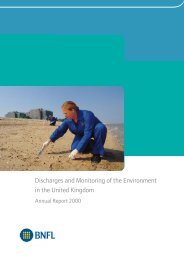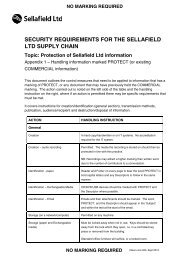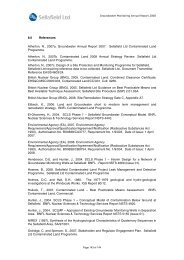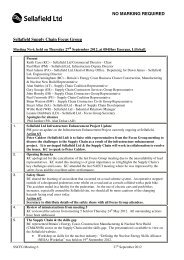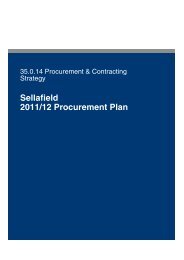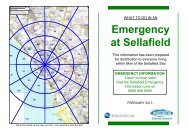Annual Report for 2010/11 and Forward Programme - Sellafield Ltd
Annual Report for 2010/11 and Forward Programme - Sellafield Ltd
Annual Report for 2010/11 and Forward Programme - Sellafield Ltd
You also want an ePaper? Increase the reach of your titles
YUMPU automatically turns print PDFs into web optimized ePapers that Google loves.
SSEM/20<strong>11</strong>/4730 June 20<strong>11</strong>large volume NaI detectors. This has enabled not only the practical examination of detectionof alpha sources by X-ray <strong>and</strong> low energy gamma emission but also the examination of thedetection of Bremsstrahlung <strong>for</strong> beta sources, which was identified as ‘potentially useful inthe future’ in the 2008 study.While technical progress is evident <strong>for</strong> two of the other techniques, large inorganicscintillation detectors <strong>and</strong> large volume High Purity Germanium (HPGe) detectors, this isinsufficient to recommend immediate implementation. It is, however, recommended that atechnology watch is maintained <strong>for</strong> these techniques as more in<strong>for</strong>mation may emerge thatwould enable their benefits to be more clearly defined.The practical implementation of FIDLER detectors has provided a reasonable proof ofprinciple <strong>for</strong> the detection of alpha emitters using X-ray <strong>and</strong> low energy gamma radiationusing thin crystal HPGe. However, there is insufficient evidence of the per<strong>for</strong>mance of thinHPGe detectors to indicate that this method would provide a significant advance inper<strong>for</strong>mance over the FIDLER detection system. It is recommended that the technologywatch be maintained <strong>for</strong> the thin crystal HPGe technology. These recommendations aresummarised in Table 7.2.For the other techniques reviewed there has either been insufficient technical developmentover the last two years or further analysis has indicated that it is unlikely that they will besuitable <strong>for</strong> this application within the next 5 years. It is recommended that these are notconsidered further.The conclusion of the BPM review of the potential beach monitoring techniques is that noneare at the level of the current best practice system based on Nuvia's Groundhog TM Synergysystem. The current Groundhog TM Synergy system meets the current beach monitoringobjectives <strong>and</strong> is expected to do so <strong>for</strong> the <strong>for</strong>eseeable future.Table 7.2. Recommendations from BPM assessment.Recommendation Timescale <strong>Report</strong> Date1. Maintain a technology watch oninorganic detector development withrespect to possible use <strong>for</strong> large areabeach monitoring.2. Maintain a technology watch on ModularHPGe <strong>and</strong> thin crystal HPGe detectordevelopment with respect to possibleuse <strong>for</strong> large area beach monitoring.3. Maintain a technology watch onemerging technology that may providedetector systems suitable <strong>for</strong> large areabeach monitoring.4. Employ the MOD's technology readinesslevel procedures to judge the abovebeach monitoring technology watch <strong>and</strong><strong>for</strong> future BPM reports.October <strong>2010</strong> – November2012October <strong>2010</strong> – November2012October <strong>2010</strong> – November2012N/AMarch 2013March 2013March 2013N/A© Nuclear Decommissioning Authority 20<strong>11</strong>. 105



